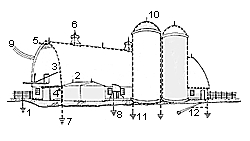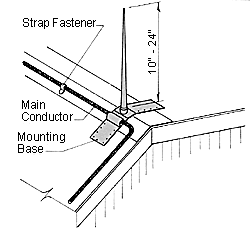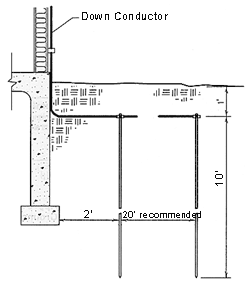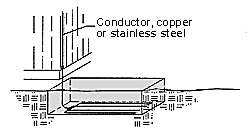The National Board of Fire Underwriters reports that lightning is the top cause
of farm fires. Lightning is also responsible for more than 80 percent of all livestock losses due
to accidents and millions of dollars in damage to farm buildings and equipment annually.
A system that protects your family, livestock and farm property from lightning strikes
prevents or significantly reduces these dangers. Lightning protection systems should be
installed only by qualified individuals who have the necessary credentials and equipment.
However, a working knowledge of the principles of lightning protection will help you to
communicate with these experts and oversee the proper maintenance of your system once
installed.
A quick primer
- Lightning is an uncontrolled, massive electric spark with tremendous voltage and
amperage.
- Lightning always tries to follow the shortest, easiest path to earth, and often
follows several paths simultaneously.
- The basic principle of lightning protection is to provide a direct, easy path for
the lightning bolt to enter or leave the earth without passing through a non-metallic
or non-conducting part of the structure or other object.
- An effective lightning protection system includes many essential parts.
- Generally, a protection system for buildings must include air terminals, down
conductors, secondary conductors, arresters and ground connections, with all system
components linked together.
- The most reliable choice is a Master Label System that meets minimum requirements
established by Underwriter Laboratories Inc. (U.L).
Back to top
How lightning behaves
Lightning is a visible discharge of static charges that can occur within a cloud,
between clouds or between a cloud and the earth. A build-up of opposite charges
(one negative and one positive) separated by an insulating air gap can cause the
charges to rush toward each other, producing a sudden release of energy. A lightning
discharge will have 10,000,000-100,000,000 Volts and 1,000-300,000 Amperage. A bolt
packs so much voltage that it may leap a mile or more through the air. Lightning strikes
buildings or other objects because the materials in them provide easier paths to ground
than the air. Lightning is more likely to strike on projecting objects such as tress,
poles, wires or building steeples than on larger, flatter surfaces projecting to the
same height or lower. Lone buildings are also primary targets.
When a lightning bolt uses a building or other object as an electrical conductor,
it generally follows a metallic path to the ground. "Sideflashes" may also occur when
current leaps from its main path to the plumbing, appliances, water lines, a person or
an animal. Sideflashes are dangerous because they can ignite a fire or cause electrocution.
Lightning can enter a building through a direct strike, by striking a metal object
attached to the building, by leaping over to the building after striking a nearby tree,
or by following a power line or ungrounded wire fence attached to a building. Utility
distribution systems use multiple groundings per mile and other protective devices to
help dissipate lightning strikes and send them to the earth.
Back to top
More about fencing systems
You can obtain a copy of the publication Installation and Operation of Fencers,
Cow Trainers and Crowd Gates from the Wisconsin Farm Electric Council. This how-to
publication explains proper grounding and lightning protection for fencing systems.
To request a copy, visit
Midwest Rural Energy Council
or call 608-262-5062 in Madison.
Back to top
Components of a lightning protection system
(1) Ground-attached wire fence (2) extend system to an addition (3) (4) (5)
run secondary conductors to litter, metal door and hay tracks (6) install terminals on
cupolas, ventilators, etc. (7) provide at least two grounds for barn (8) tie in metal
stanchions 9) install arresters on overhead wires

(10) provide at least one terminal on each domed silo and at least two on each
flat-roof or unroofed silo (11) ground silo (12) connect to metal water pipe; and
protect all buildings — valuable or not — within 50' of barn.
A lightning protection system should be installed for all important farm buildings,
including barns, loafing sheds, houses and other structures. Protection may also be
warranted for trees, wire fences and minor buildings.
Back to top
A typical air terminal
A good lightning protection system protects all points where a bolt is likely to
strike and all objects to which the current might sideflash.
The five key parts of a system are:
- Air terminals (lightning rods)
- Down (or main) conductors
- Secondary conductors
- Lightning arresters
- Ground connections or rods

Air terminals, or lightning rods, are designed to take any lightning bolt that may
strike in the immediate area. Installed at high points, air terminals are pointed metal
rods or tubes. Proper height and spacing of the terminals depends on the building
configuration. Terminals are installed along roofs and on all projections such as
chimneys, flagpoles, towers, dormers, ventilators and water tanks. Down (or main)
conductors conduct the lightning bolt safely from the point struck to the ground.
They connect air terminals with each other and with grounds. Each down conductor
should have a separate ground.
Secondary conductors connect metal parts of a building together. The electrical
bond this creates keeps lightning from flashing across the gap between the metal
parts. All secondary conductors are connected to the main conductors. Numerous
metal parts that are part of or attached to a building may need this protection.
Metal roofing is a common trouble spot if not properly grounded. Other examples
include metal hay tracks, door tracks, troughs, storage tanks, stalls, stanchions,
milking lines, water lines, pipes, conveyors, long metal ducts, concrete reinforcement
and more.
Arresters protect a building's wiring system from the dangerous surges of
electricity associated with lightning strikes.

Ordinary circuit breakers cannot handle a power surge caused by lightning. Arresters
protect wiring and electrical equipment by diverting power from the hot wire and safely
guiding it to ground. Each arrester is connected to the building's lightning protection
ground system. Arresters can be used to protect expensive electrical equipment and
solid-state control panels in grain drying systems, milking/feeding equipment and computers.
Ground connections for the lightning system are essential, causing lightning charges to
dissipate without causing harm. Proper grounding installation varies depending on the
depth of the soil and its conductivity.
Proper grounding depends on the depth of the soil and its conductivity. In sandy
soils, two or three ground rods are installed in parallel and connected.
All grounding conductors should be bonded together, including telephone and electric
service grounds, antenna grounds, all underground metal pipes and lightning protection
systems. This prevents dangerous sideflashes between grounding conductors that are close
together.

For clay soils, one ground rod is often used. Ground rods are driven 10' deep and
placed at least 2' from the foundation wall. In shallow topsoil, grounding can be
achieved by stranding the conductor and burying it in a long trench or attaching it to a
copper ground plate.
Back to top
Materials and installation
Materials used in lightning protection systems must resist corrosion. Copper and
aluminum cable are the most common, while copper alloys and copper-clad steel are also
approved materials. Aluminum conductors corrode when in contact with earth. They should
terminate at least one foot above ground level and connect with corrosion-resistant,
copper conductors using special bi-metal connectors or connectors with an oxidation
inhibitor. In other situations, combinations of materials subject to electrolytic
action should be avoided.
Proper installation is also critical, and should be done only by a qualified expert.
Before you select an installer, check references and verify the installer's experience
level with similar projects. Your insurance company may be able to recommend a qualified
installer. To obtain approval from the Underwriters Laboratories Inc. for a Master Label,
a special application form must be signed by the owner, the installer and the equipment
manufacturer. If all materials and workmanship meet the minimum requirements established
by the U.L., a Master Label identification plate will be issued directly to the owner.
If you have an older farm with an existing lightning protection system, consult an
installer about upgrading the system to incorporate more modern materials and up-to-date
lightning protection techniques. While no system can guarantee 100% protection against
the unpredictability of lightning strikes, an effective lightning protection system can
go a long way toward protecting your family, livestock, buildings and equipment from
this hazardous weather condition. Lightning protection is a form of insurance no farm
should be without.
Back to top
Maintaining your system
Even the best lightning protection system can become ineffective over time if
it is not properly maintained. Remember to take these important steps, and consult
your installer for additional maintenance pointers.
- Inspect the system periodically for mechanical damage caused by equipment
or livestock.
- Check for corrosion of any system parts.
- Check the fasteners that attach the down conductors to buildings. Aluminum
down conductors should not be blowing in the wind.
- Connectors to ground rods should be free of corrosion and should form solid
connections.
- Wire connections to buildings must not be damaged or severed.
- If new electrical work is done on the farm, make sure all new installations
are properly connected to the lightning protection system.
Just one weak link can cause a lightning protection system to fail. Promptly
correct any problems that may compromise the integrity of your system.
Back to top